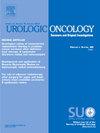Serum Markers as predictors for treatment benefit in castration-resistant prostate cancer
IF 2.3
3区 医学
Q3 ONCOLOGY
Urologic Oncology-seminars and Original Investigations
Pub Date : 2025-08-06
DOI:10.1016/j.urolonc.2025.06.018
引用次数: 0
Abstract
Purpose
While most prostate cancer patients initially respond to androgen-deprivation therapy (ADT), they will develop castration-resistance leading to progressing to castration-resistant prostate cancer (CRPC). Different treatment options are available for CRPC, including androgen receptor pathway inhibitors (ARPIs) and docetaxel (DOC). As tissue samples are difficult to access at this stage, blood-based analyses offer a more feasible approach. Therefore, we examined whether serum markers could potentially support treatment decisions in CRPC.
Materials and Methods
Overall survival (OS) was examined in 208 CRPC patients treated with either ARPIs or DOC. Serum markers were chosen to reflect relevant tumor properties: serum thymidine kinase 1 (sTK1) as a proliferation-associated marker, TPS (tissue polypeptide specific antigen) as an epithelial marker, and prostate-specific antigen (PSA).
Results
A median OS (mOS) time of 19.6 (IQR: 9.5–35.4) months was observed for the whole cohort. Patients with sTK1high/TPShigh levels treated with ARPIs showed a mOS time of 6.8 (IQR: 4.2–9.5) months, compared to 14.6 (IQR: 8.7–48.9) months for patients receiving DOC (P = 0.024). Patients with sTK1low and/or TPSlow levels showed similar mOS times irrespective of treatment. Combinations of sTK1 and TPS with PSA yielded similar findings for ARPI-treated patients and longer OS in DOC-treated patients.
Conclusions
This study introduces the concept of identifying proliferating carcinomas using a combination of the serum biomarkers sTK1 and TPS. The results suggest that sTK1high/TPShigh CRPC patients derive more benefit from DOC, consistent with known mechanisms of drug action. Further randomized studies will be required to prove the therapy-predictive value of these tumor markers in CRPC.
血清标志物作为去势抵抗性前列腺癌治疗效果的预测指标。
目的:虽然大多数前列腺癌患者最初对雄激素剥夺治疗(ADT)有反应,但他们会发展为去势抵抗,从而发展为去势抵抗性前列腺癌(CRPC)。CRPC有不同的治疗选择,包括雄激素受体途径抑制剂(arpi)和多西他赛(DOC)。由于在这个阶段很难获得组织样本,基于血液的分析提供了一种更可行的方法。因此,我们研究了血清标志物是否可能支持CRPC的治疗决策。材料和方法:研究208例接受arpi或DOC治疗的CRPC患者的总生存期(OS)。选择血清标志物来反映肿瘤的相关特性:血清胸苷激酶1 (sTK1)作为增殖相关标志物,TPS(组织多肽特异性抗原)作为上皮标志物,前列腺特异性抗原(PSA)。结果:整个队列的中位OS (mOS)时间为19.6 (IQR: 9.5-35.4)个月。接受arpi治疗的sTK1high/ tphigh患者的mOS时间为6.8 (IQR: 4.2-9.5)个月,而接受DOC治疗的患者的mOS时间为14.6 (IQR: 8.7-48.9)个月(P = 0.024)。无论接受何种治疗,sTK1low和/或TPSlow水平患者的mOS时间相似。sTK1和TPS联合PSA在arpi治疗的患者中获得了类似的结果,在doc治疗的患者中获得了更长的生存期。结论:本研究引入了使用血清生物标志物sTK1和TPS联合识别增殖性癌的概念。结果表明sTK1high/ tphigh CRPC患者从DOC中获益更多,与已知的药物作用机制一致。需要进一步的随机研究来证明这些肿瘤标志物在CRPC中的治疗预测价值。
本文章由计算机程序翻译,如有差异,请以英文原文为准。
求助全文
约1分钟内获得全文
求助全文
来源期刊
CiteScore
4.80
自引率
3.70%
发文量
297
审稿时长
7.6 weeks
期刊介绍:
Urologic Oncology: Seminars and Original Investigations is the official journal of the Society of Urologic Oncology. The journal publishes practical, timely, and relevant clinical and basic science research articles which address any aspect of urologic oncology. Each issue comprises original research, news and topics, survey articles providing short commentaries on other important articles in the urologic oncology literature, and reviews including an in-depth Seminar examining a specific clinical dilemma. The journal periodically publishes supplement issues devoted to areas of current interest to the urologic oncology community. Articles published are of interest to researchers and the clinicians involved in the practice of urologic oncology including urologists, oncologists, and radiologists.

 求助内容:
求助内容: 应助结果提醒方式:
应助结果提醒方式:


